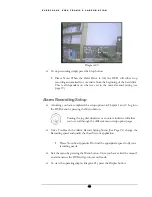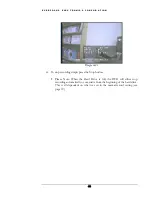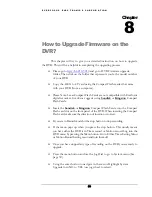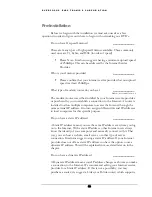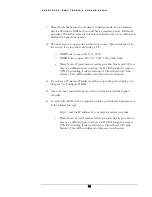
E V E R F O C U S E L E C T R O N I C S C O R P O R A T I O N
56
Networking Overview
This chapter will try to give you a detailed instruction on how to network
the DVR. Before we begin the process of networking your digital recorder we
should have a working knowledge of what a network is and how it works. This
will be a helpful in completing the networking process.
Introduction to TCP/IP
TCP/IP is the suite of protocols used by the Internet and most LANs
(Local Area Networks) throughout the world. In TCP/IP, every host (computer
or other communications device) that is connected to the network has a unique IP
address. By doing this you are giving your device a unique address similar to the
address of your house. An IP address is composed of four octets (numbers in the
range of 0 to 255) separated by decimal points. The IP address is used to uniquely
identify a host or computer on the LAN. For example, a computer with the
hostname Workstation could have an IP address of 192.168.1.127.
You should avoid giving two or more computers the same IP address by
using the range of IP addresses that are reserved for private, local area networks;
this range of IP addresses usually begins with the octets 192.168. The first three
octets of an IP address should be the same for all computers in the local area
network. For example, if a total of 253 computers exist in a single LAN, the IP
addresses could be assigned starting with 192.168.1.
x
, where
x
represents a
number in the range of 2 to 254.
Subnet Masks
Each host in a LAN has a subnet mask. The
subnet mask
is an octet that uses the
number 255 to represent the network address portion of the IP address and a zero to
identify the host portion of the address. For example, the subnet mask 255.255.255.0 is
used by each host to determine which LAN or class it belongs to. The zero at the end
of the subnet mask represents a unique host within that network. Basically the subnet
mask represents the city you live in for your home address, but in this case you are
stating the network you belong too.
Chapter
9
Summary of Contents for EDSR400H
Page 1: ...Instruction Manual E ED DS SR R4 40 00 0H H Volume 1 ...
Page 66: ...E V E R F O C U S E L E C T R O N I C S C O R P O R A T I O N 62 ...
Page 67: ...E V E R F O C U S E L E C T R O N I C S C O R P O R A T I O N 63 ...
Page 68: ...E V E R F O C U S E L E C T R O N I C S C O R P O R A T I O N 64 ...
Page 85: ...E V E R F O C U S E L E C T R O N I C S C O R P O R A T I O N 81 ...
Page 91: ...E V E R F O C U S E L E C T R O N I C S C O R P O R A T I O N 87 ...
Page 95: ...91 ...
Page 96: ...92 ...
Page 97: ...93 Remote Control Appendix A ...
Page 98: ...94 Time Lapse Mode Recording Time Appendix B ...
Page 99: ...95 ...
Page 100: ...96 Alarm Board Configuration Appendix C ...
Page 101: ...97 ...
Page 102: ...98 ...
Page 106: ......
Page 107: ......


